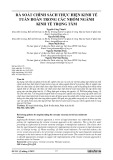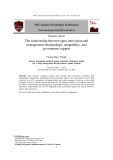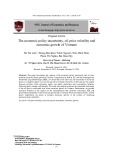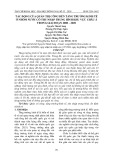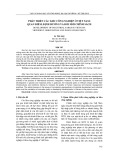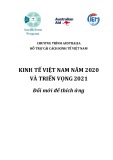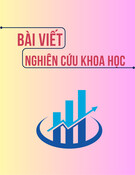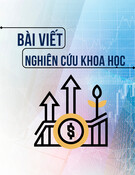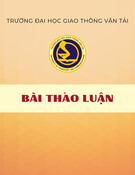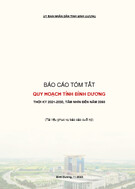
27
Journal of Economic and Banking Studies
No.8, Vol.4 (2), December 2024 pp.27-37
©
Banking Academy of Vietnam
ISSN 2734 - 9853
The impact of Economic Policy Uncertainty on firm
performance in Vietnamese listed companies
Nguyen, Thi Hoa Hong1 - Pham, Tuan Kien2 - Ha, Gia Linh3
- Nguyen, Vu Ha Thanh4 - Nguyen, Le Tuan5 - Phung, Duc Anh6
Foreign Trade University, Vietnam
Corresponding Authors.
E-mail address: hongnth@ftu.edu.vn (Nguyen, T. H. H.), k59.2012280018@ftu.edu.vn (Pham, T. K.),
k59.2013280019@ftu.edu.vn (Ha, G. L.), k59.2013280032@ftu.edu.vn (Nguyen, V. H. T.), k59.2012280041@ftu.
edu.vn(Nguyen, L. T.), k59.2013280005@ftu.edu.vn (Phung, D. A.)
Chronicle Abstract
Article history This study examines the impact of economic policy uncertainty (EPU) on
the performance of Vietnamese listed companies from 2010 to 2022. EPU
is measured by standardizing the search volume index of relevant key-
words using data from Google Trends and Glimpse. The findings from re-
gression models show a negative relationship between economic policy
uncertainty and both return on total assets and return on equity in Vietnam
during the period of 2010-2022. This study provides additional evidence in
emerging markets to reinforce the negative impact of EPU on firm perfor-
mance and supplements a new measurement of EPU in Vietnam. Further-
more, the study suggests that the government should formulate strategies
to leverage economic advantages, thereby enabling firms to sustain their
economic activities.
Received
Revised
Accepted
28th Mar 2024
19th May 2024
20th May 2024
Keywords
Economic Policy Uncertain-
ty (EPU),
Firm performance,
Listed companies,
Return on total assets,
Return on equity
DOI:
10.59276/JEBS.2024.12.2672
1. Introduction
In recent years, the world has witnessed an
unprecedented array of upheavals that have
shaken the global economic landscape,
ranging from trade tensions between the United
States and China, the COVID-19 pandemic,
to the Russia-Ukraine and most recently, the
Israeli–Palestinian conflict. The interconnected-
ness of economies in the modern era means that
economic shocks in one part of the world can
have far-reaching implications for the global
economy and trade (Yu et al., 2021; Dées &
Galesi, 2021; Guenette et al., 2022). Vietnam,
as a developing country with a high degree of
integration and openness, is also impacted by
these shocks (Anh & Gan, 2021; Tien et al.,
2019; Tien & Anh, 2019; Nguyen, 2023; Riedel,
2009). The Vietnamese government has consis-
tently introduced and revised various policies to
cope with the changing domestic and interna-
tional situations (Gates et al., 1995; Nguyen &
Mort, 2016; Nguyen et al., 2017).
However, not all nations effectively improve
and implement economic policies, resulting
in unstable and inconsistent policy measures,
known as “Economic Policy Uncertainty”
(EPU) (Rodrik, 1991). EPU is a term that en-
compasses a cluster of items related to unpre-
dictability in various economic policies and their
impact on the economy, financial markets, and
corporate behavior (Smales, 2020; Al-Thaqeb &

The impact of Economic Policy Uncertainty on firm performance in Vietnamese listed companiest
28
Journal of Economic and Banking Studies- No.8, Vol.4 (2), December 2024
Algharabali, 2019). EPU can arise from various
sources, such as fiscal policy, monetary policy,
national security, financial regulations, health
care policy, entitlement programs, trade policy,
sovereign debt, and currency crises (Baker et
al., 2016). These inconsistencies can increase
the probability and duration of recessions and
reduce the probability of an economic recession
ending (Nguyen, 2022).
Another important factor that affects the eco-
nomic development and stability of a country is
the performance of its business organizations.
Firm performance can be briefly described as
the efficient utilization of organizational re-
sources to achieve objectives and results consis-
tent with the set goals of the company (Peterson
et al., 2003). It emphasizes a dynamic perspec-
tive, requiring judgment and interpretation, with
indicators encompassing both financial and non-
financial aspects. Firm performance can be mea-
sured by various indicators, notably Return on
Total Assets (ROA), Return on Equity (ROE),
Tobin’s Q, Profit Margin (PM) ... These indica-
tors capture different aspects of firm perfor-
mance and can be used to compare firms across
industries and countries. Due to its importance,
researchers, policymakers, and regulators have
always wanted to figure out the main drivers of
and barriers to firm performance.
Firm performance can be influenced by both
internal and external factors, such as informa-
tion technology (Chen & Zhu, 2004; Wang et
al., 1997; Kao & Hwang, 2010; Sabherwal &
Jeyaraj, 2015), industry structure (Karabag &
Berggren, 2014, Adetunji & Owolabi, 2016),
organization-specific factors (Adetunji &
Owolabi, 2016, Oerlemans & Meeus, 2005, Bae
& Lawler, 2000). Among the external factors,
EPU is a rising source of risk that firms face
(Kang & Ratti, 2015). EPU can have nega-
tive impacts on firm performance by reducing
investment, employment, revenue, and risk-
taking (Feng et al., 2021; Iqbal et al., 2020; Liu
et al., 2020; Wang et al., 2020). However, the
effects of EPU on firm performance may vary
depending on the ownership structure, gover-
nance mechanism, and institutional environment
of firms (Feng et al., 2021; Liu et al., 2020).
These factors can affect how firms cope with
EPU and adjust their investment, employment,
revenue, and risk-taking strategies. Therefore, it
is important to examine how EPU affects firm
performance in different contexts and settings.
However, previous research on the relationship
between economic policy uncertainty and firm
performance has predominantly focused on
developed economies. There is a limited body
of research that specifically investigates this
relationship in emerging markets, and Vietnam
presents a unique context for such an analysis.
The Vietnamese business environment is char-
acterized by rapid changes in policies, a diverse
economic structure, and a mix of state-owned
and private enterprises. Therefore, understand-
ing how these factors interact, and influence
firm performance is of paramount importance.
In this paper, we focus on the case of Vietnam,
a developing country with a transition economy
that has experienced rapid growth and integra-
tion in recent years.
This study has two significant contributions to
the extant literature. Firstly, it provides addition-
al evidence in emerging markets to reinforce the
negative impact of EPU on firm performance as
shown in previous studies (Tran, 2019; Iqbal et
al., 2020; Vural-Yavaş, 2020; Hou et al., 2021;
Wen et al., 2021; Zhang et al., 2021; Afridi &
Suleman, 2022; Ahsan et al., 2023; García-
Gómez et al., 2023; Kong et al., 2022; Liu et al.,
2022; Feng et al., 2023; Syed, 2023). Secondly,
the study supplements a new measure of EPU
by standardizing the search volume index of
related keywords on popular search engines. A
supplementary research data set on economic
policy uncertainty from 2010 to 2022 in Viet-
nam was also introduced by the study.
The remainder of this paper is organized as fol-
lows. Section 2 reviews the previous studies and
develops the hypothesis. The data collection,
research models and methods are presented in
Section 3. The empirical results are reported in
Section 4. Finally, Section 5 summarizes major
findings and provides some recommendations.
2. Literature review and hypothesis devel-
opment

Nguyen, Thi Hoa Hong - Pham, Tuan Kien - Ha, Gia Linh
- Nguyen, Vu Ha Thanh - Nguyen, Le Tuan - Phung, Duc Anh
29
No.8, Vol.4 (2), December 2024 - Journal of Economic and Banking Studies
A consistent finding across previous studies is
the negative relationship between EPU and firm
performance. This is evidenced in the research
conducted by Iqbal et al. (2020) on US-listed
non-financial firms, Ahsan et al. (2023) on
European firms, and García-Gómez et al. (2023)
on US tourism firms. These studies collectively
indicate that increased EPU tends to result in de-
creased firm performance, as measured by vari-
ous indicators such as Return on Total Assets,
Return on Equity, Net Profit Margin, and Tobin’s
Q. Moreover, existing literature also highlights
the role of firm characteristics in moderating
the impact of EPU on firm performance. For
instance, García-Gómez et al. (2023) found that
firm size and leverage can moderate the EPU-
firm performance relationship. Similarly, Feng
et al. (2023) found that the negative relationship
between EPU and firm performance was less
pronounced in state-owned enterprises com-
pared to non-state-owned enterprises in China.
In addition to findings about the impact of EPU
on overall firm performance, various literature
also found links between EPU and the impact
on specific dimensions such as financial perfor-
mance. Rjiba et al. (2020) found that Corporate
Social Responsibility (CSR) can counterbalance
the adverse effects of EPU on Corporate Finan-
cial Performance (CFP). In terms of financial
stability, both Alam et al. (2023) and Phan et al.
(2019) discovered that EPU has a detrimental
impact. However, Alam et al. (2023) noted that
political connections could mitigate this effect.
More interestingly, Makosa et al. (2021) found
that EPU initially reduces financial constraints
but increases them over time. These findings
suggest that while EPU can negatively impact
firm financial performance, factors such as CSR,
political connections, and the timeframe consid-
ered can significantly influence these effects.
Apart from a direct impact on a firm’s overall
performance and financial performance, EPU can
impact various aspects of a firm’s operations and
financial decisions, which in turn can influence
the firm’s overall performance. For instance, Tran
(2019), Wen et al. (2021), Vural-Yavaş (2020),
and Zhang et al. (2021) discover a negative cor-
relation between economic policy uncertainty and
corporate risk-taking, emphasizing risk-averse
behavior in uncertain economic climates. In the
context of productivity, Li et al. (2023) find that
economic policy uncertainty negatively affects
productivity in China. Moreover, studies across
various industries, including the hospitality sector
(García-Gómez et al., 2023), reveal that econom-
ic policy uncertainty leads to increased firm-level
investment inefficiency (Kong et al., 2022; Liu et
al., 2022; Hou et al., 2021; Syed, 2023; Afridi &
Suleman, 2022). Stock liquidity, an essential facet
of firm performance, is adversely affected, with
Wang et al. (2022), Mbanyele (2023), and Zhang
et al. (2023) highlighting the negative impact of
economic policy uncertainty on stock liquidity,
particularly in opaque information environments.
Vietnam has undergone significant economic
reforms since the late 1980s, such as privatiza-
tion of SOEs, liberalization of trade and invest-
ment, deregulation of prices and interest rates,
and stabilization of inflation and exchange rates.
These reforms have improved the efficiency
and competitiveness of Vietnamese firms and
attracted foreign direct investment (FDI) from
various countries. However, Vietnam also faces
many challenges in its economic development
process, such as high public debt, low productiv-
ity growth, environmental degradation, social
inequality, and geopolitical tensions. These
challenges create uncertainty about the future
direction and sustainability of economic policies
in Vietnam. Moreover, Vietnam is also exposed
to external shocks from global events that affect
its major trading partners or sources of FDI. For
example, Vietnam was affected by the global
financial crisis in 2008-2009, the US-China trade
war in 2018-2019, and the COVID-19 pandemic
in 2020-2021. These events increased the volatil-
ity and unpredictability of economic policies in
Vietnam and other countries.
While some studies suggest positive outcomes,
indicating adaptive governance mechanisms
and enhanced ESG practices during uncertain
economic times, the preponderance of evi-
dence leans toward the negative consequences.
Thus, the main hypothesis is: EPU has a nega-
tive impact on the performance of Vietnamese
listed companies.

The impact of Economic Policy Uncertainty on firm performance in Vietnamese listed companiest
30
Journal of Economic and Banking Studies- No.8, Vol.4 (2), December 2024
statements or reports were also omitted, ensur-
ing the uniformity and integrity of the data.
To fortify the rigor of our analysis, a stringent
process of eliminating data points that fell
outside the 5th and 95th percentiles for each
variable was also applied, thereby mitigating
the impact of outliers. Following this process,
the final dataset consists of 556 companies,
yielding a total of 6,172 observations in the
period from 2010 to 2022.
Following the guidelines of the Industry Classi-
fication Benchmark (ICB) with modification in
the Vietnam context, the final research sample is
classified by sectors as presented in Table 2.
3.2. Research Models and Methods
To evaluate the effect of Economic Policy
Uncertainty (EPU) on firm performance, the
Ordinary Least Square (OLS), Fixed Effect
Model (FEM), Random Effect Model (REM)
regression models and other statistical tests
3. Research methodology
3.1. Data and sampling
The study includes an examination of data from
774 enterprises listed on Vietnam stock exchang-
es, namely the Ho Chi Minh Stock Exchange
(HOSE) and the Hanoi Stock Exchange (HNX),
covering the time frame from 2010 to 2022. Sec-
ondary data were collected from diverse sources,
encompassing corporate financial statements,
annual reports, and the FiinPro database.
A portion of the initially acquired data, roughly
one-third, underwent exclusion during the anal-
ysis. Specifically, companies within the bank-
ing and finance sectors were omitted due to
their unique scale and distinctive management
practices, which had the potential to introduce
bias. This selective measure was taken to
uphold the research’s objectivity. Furthermore,
any firms failing to meet predetermined criteria
for the disclosure of financial data within their
Table 1. Sample selection
Total number of listed companies 774
(1) Eliminate companies in the banking and finance industry 148
(2) Eliminate companies that do not have enough information on annual
reports and financial statements
70
Total number of remaining companies 556
The ratio of the sample to the total number of original samples 71.83%
Source: Authors’ compilation
Table 2. Distribution of samples by industry
Industry Number of firms Number of firm-years
Industrials 230 2,599
Basic Material 90 990
Consumer Goods 90 963
Consumer Services 55 596
Community Amenities 46 527
Health Care 23 252
Technology 17 182
Oil and gas 5 63
Final sample 556 6,172
Source: Authors’ compilation

Nguyen, Thi Hoa Hong - Pham, Tuan Kien - Ha, Gia Linh
- Nguyen, Vu Ha Thanh - Nguyen, Le Tuan - Phung, Duc Anh
31
No.8, Vol.4 (2), December 2024 - Journal of Economic and Banking Studies
were applied for the Equation (1).
FPit = α0 + α1EPUt + α2SOit + α3LEVit +
α4AGEit + α5REVit + α6BVPSit + α7LIQit +
α8RMit + εit (1)
The subscripts i and t represent firm i and year t
respectively. The dependent variable FP (Firm
Performance) is measured by two indexes:
Return on Total Assets (ROA) and Return on
Equity (ROE). EPU for each research year is
measured by standardizing the search volume
index of related keywords using tools such as
Google Trends and Glimpse. The chosen key-
words are diverse and categorized based on the
synonym formula of “(1) economic + (2) policy
+ (3) uncertainty.” In this investigation, EPU-re-
lated keywords include economic policies, fiscal
regulations, trade agreements, and significant
economic events. Table 3 depicts all variables
used in the proposed empirical model.
4. Empirical results
4.1. Descriptive statistics and matrix correlation
Table 4 provides descriptive statistics of ten
distinct variables, denoted as ROA, ROE,
EPU, SO, AGE, REV, BVPS, LIQ, and RM.
The total sample size for all variables is 6,172
observations.
ROA shows a wide spectrum of values, rang-
ing from -0.625 to 0.812, with the mean stands
at 0.069, and a standard deviation of 0.081.
These statistics offer valuable insights into the
profitability of the firms under our scrutiny.
While, on average, companies exhibit a favor-
able return on total assets, the broad range of
values underscores the substantial diversity in
this aspect among the entities. This variation
reflects the multifaceted nature of their busi-
ness operations and financial performance.
For the ROE variable, the range stretches
from -1.514 to 2.27, with a computed mean of
0.116 and a corresponding standard deviation
of 0.181. These figures exemplify the hetero-
geneity in return on equity among the firms in
our sample. Even though certain firms report
negative income, the overall mean remains in
the positive realm, signifying that, on average,
business activities are on an upward trajectory.
As per EPU, it spans from 0.021 to 1 with a
mean of 0.271, and the standard deviation is
0.277. These data patterns spotlight the rela-
tively low emphasis placed on economic policy
uncertainty by the firms in our sample during
the 2010-2022 period. This is corroborated by
the notably low proportion of search volume
related to this topic, suggesting a decreased
level of concern and attention among the firms.
The SO variable ranges values from 0 to 1, with a
mean of 0.252 and a standard deviation of 0.258.
This variable implies the extent of government
ownership in a company, with higher values
showing a broader government stake. The mean
value of the LEV variable is 1.519, considered
a safe threshold for all firms. The AGE variable
indicates the number of establishment years of
the business, with an average of 3.138, which is
relevant to 23 years. The youngest firm has been
established for 5 years, while the oldest firm is 75
years old. Vietnamese listed companies are rela-
tively young, in comparison to other economies,
which are usually equitized from state-owned
enterprises. The REV variable implies company
revenue, which is 27.167 on average, correspond-
ing to total assets of VND 754.257 billion. This
variation can be supported by the diversity in
industries and business fields. The LIQ vari-
able ranges from 0 to 15.741, with a mean of
2.144 and a standard deviation of 1.987. This
variable indicates a firm’s capability to obligate
its responsibility in the short term, with higher
values implying enhanced liquidity and diminish-
ing default risk. The BVPS variable ranges from
-0.202 to 7.921, with a mean value of 0.757 and
a standard deviation of 0.409. BVPS represents
a firm’s net asset value on a per-share basis. The
variable’s range and distribution inform about
the relative undervaluation or overvaluation of
the companies’ stocks within the sample, with
higher BVPS values indicating more undervalued
stocks. The RM variable spans values from 0 to
1, with a mean of 0.183 and a standard deviation
of 0.387. This shows that risk management ac-
tivities in Vietnam are still underrated, and there
is still much more potential to improve operations
quality in the future.



